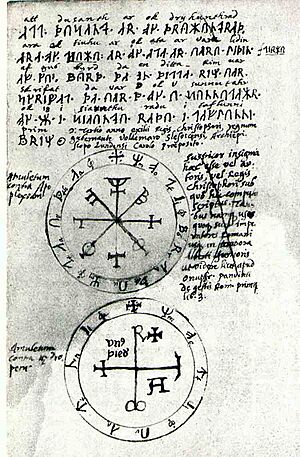Petosiris to Nechepso facts for kids
The text known as Petosiris to Nechepso is like an old letter. It describes a special way to predict the future using numbers and a drawing. It's thought that this letter wasn't actually written by Petosiris or Nechepso. Instead, someone else probably wrote it, pretending to be them. Petosiris and Nechepso are famous figures. Some people believe they started the study of astrology, which is about how stars and planets might affect our lives.
One version of this letter was translated into Latin. People think Saint Bede, a very old and wise scholar, might have done this translation. You can find this old copy in a place called the British Library.
What is the Petosiris Circle?
This special method has many names. People call it the Petosiris Circle, the Sphere of Apuleius, Columcille's Circle, or Democritus's Sphere. Giving old, famous names to new ideas was common long ago. This method might have come from a group of thinkers called Neoplatonism and Gnosticism. We know about these drawings from very old books made in Anglo-Saxon times.
How Does the Circle Work?
The method uses a diagram and numbers to guess what might happen. First, you take a person's name. Then, you turn the letters of their name into numbers. After that, you divide this total number by 29 or 30. These numbers come from the length of the lunar month, which is how long it takes the Moon to go around the Earth.
The important part is the number that is left over after you divide. This leftover number is then found on the special diagram. The spot where the number is found on the diagram tells you the prognosis, or what is predicted to happen.
See also


